Business Law: Roles of Government and Business Structures Analysis
VerifiedAdded on 2023/01/19
|13
|3892
|62
Report
AI Summary
This business law report delves into various aspects of the legal framework governing businesses in England and Wales. It begins by outlining the roles of the executive, judiciary, and legislature, emphasizing their separation of powers. The report then examines the remedy of specific performance and its limitations, providing an employment law case study to illustrate the application of these principles. Furthermore, it differentiates between general partnerships and companies, focusing on separate legal personality and limited liability. Finally, the report discusses the legal process of employee dismissal, offering a comprehensive analysis of key business law concepts and their practical implications.
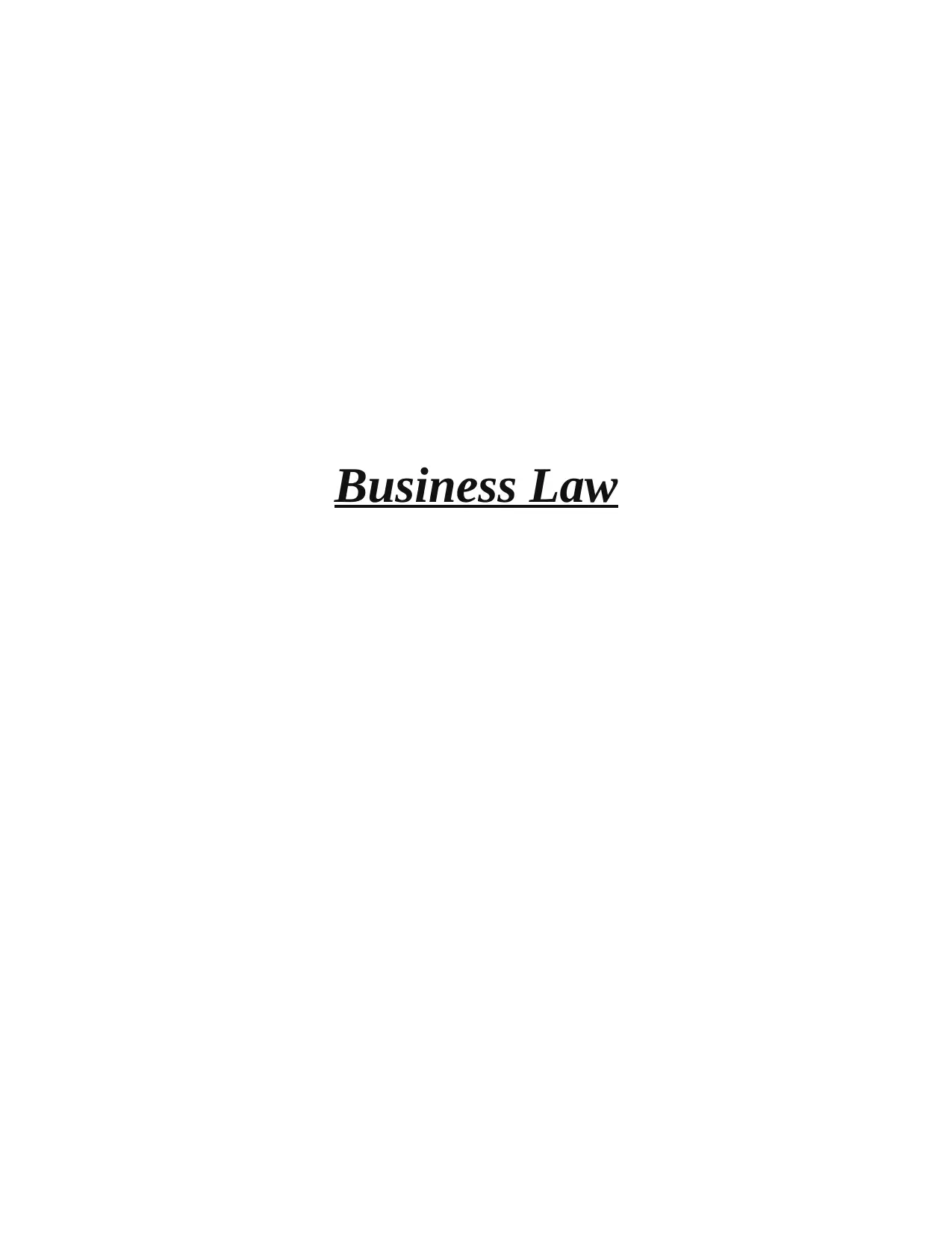
Business Law
Paraphrase This Document
Need a fresh take? Get an instant paraphrase of this document with our AI Paraphraser
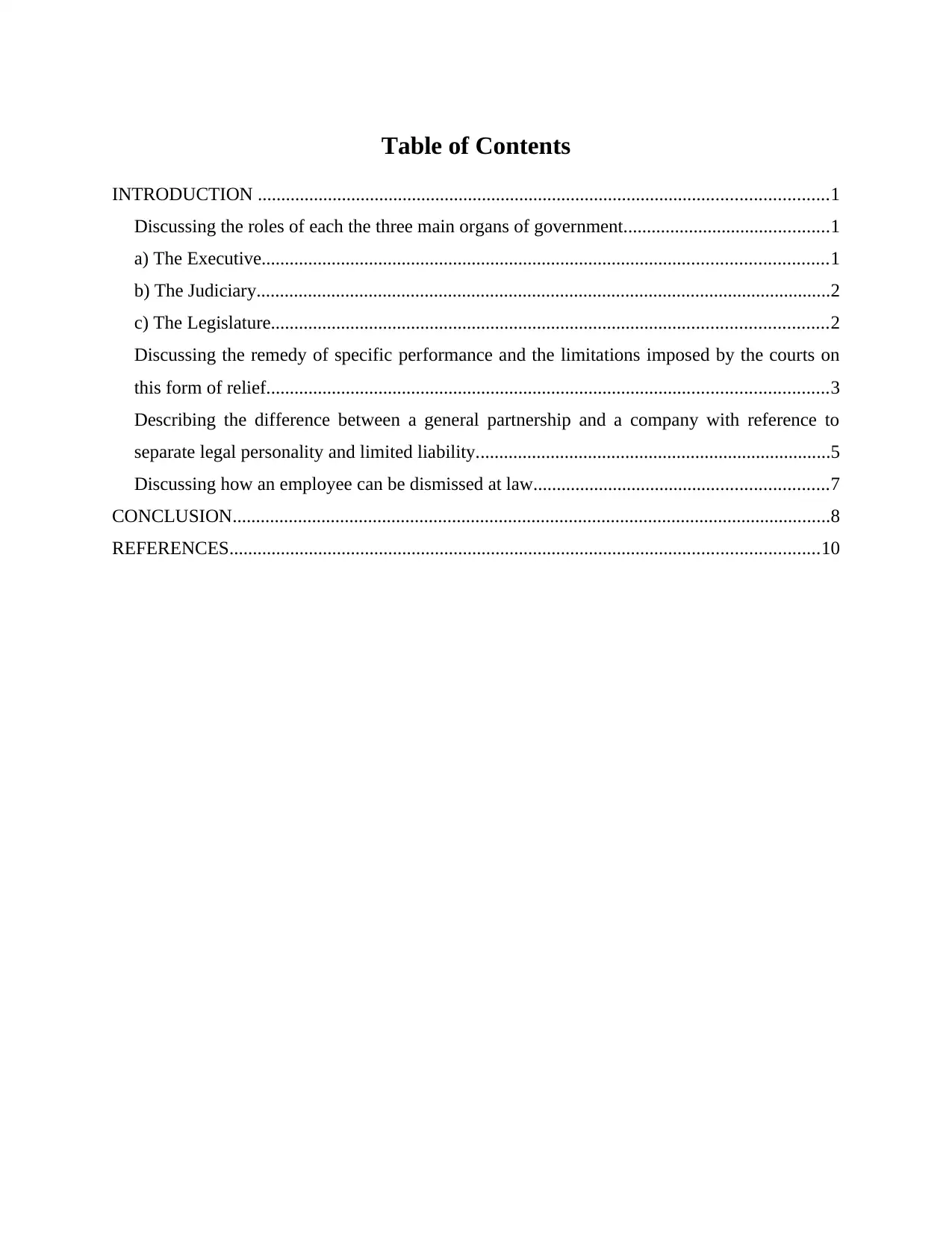
Table of Contents
INTRODUCTION ..........................................................................................................................1
Discussing the roles of each the three main organs of government............................................1
a) The Executive.........................................................................................................................1
b) The Judiciary...........................................................................................................................2
c) The Legislature.......................................................................................................................2
Discussing the remedy of specific performance and the limitations imposed by the courts on
this form of relief........................................................................................................................3
Describing the difference between a general partnership and a company with reference to
separate legal personality and limited liability............................................................................5
Discussing how an employee can be dismissed at law...............................................................7
CONCLUSION................................................................................................................................8
REFERENCES..............................................................................................................................10
INTRODUCTION ..........................................................................................................................1
Discussing the roles of each the three main organs of government............................................1
a) The Executive.........................................................................................................................1
b) The Judiciary...........................................................................................................................2
c) The Legislature.......................................................................................................................2
Discussing the remedy of specific performance and the limitations imposed by the courts on
this form of relief........................................................................................................................3
Describing the difference between a general partnership and a company with reference to
separate legal personality and limited liability............................................................................5
Discussing how an employee can be dismissed at law...............................................................7
CONCLUSION................................................................................................................................8
REFERENCES..............................................................................................................................10
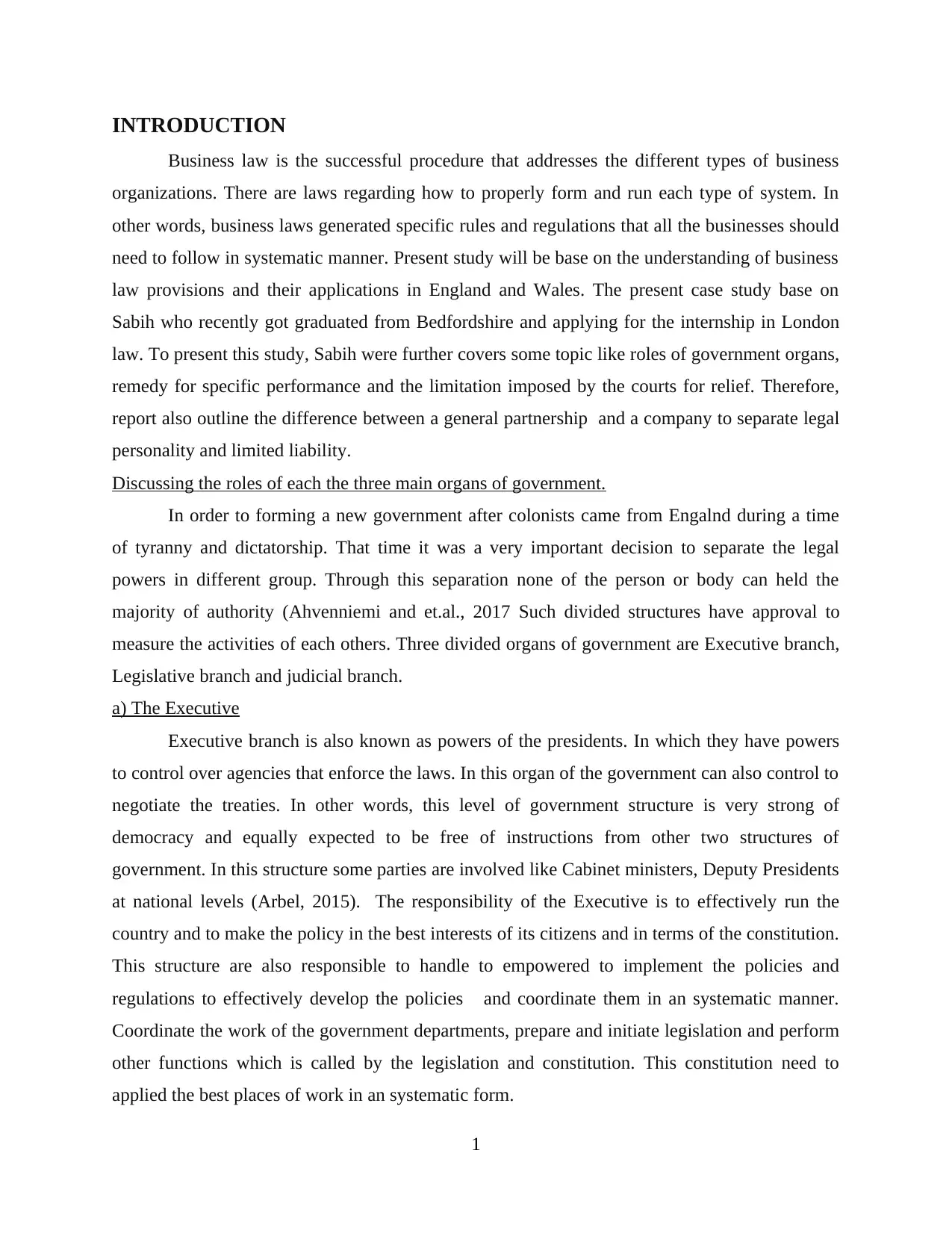
INTRODUCTION
Business law is the successful procedure that addresses the different types of business
organizations. There are laws regarding how to properly form and run each type of system. In
other words, business laws generated specific rules and regulations that all the businesses should
need to follow in systematic manner. Present study will be base on the understanding of business
law provisions and their applications in England and Wales. The present case study base on
Sabih who recently got graduated from Bedfordshire and applying for the internship in London
law. To present this study, Sabih were further covers some topic like roles of government organs,
remedy for specific performance and the limitation imposed by the courts for relief. Therefore,
report also outline the difference between a general partnership and a company to separate legal
personality and limited liability.
Discussing the roles of each the three main organs of government.
In order to forming a new government after colonists came from Engalnd during a time
of tyranny and dictatorship. That time it was a very important decision to separate the legal
powers in different group. Through this separation none of the person or body can held the
majority of authority (Ahvenniemi and et.al., 2017 Such divided structures have approval to
measure the activities of each others. Three divided organs of government are Executive branch,
Legislative branch and judicial branch.
a) The Executive
Executive branch is also known as powers of the presidents. In which they have powers
to control over agencies that enforce the laws. In this organ of the government can also control to
negotiate the treaties. In other words, this level of government structure is very strong of
democracy and equally expected to be free of instructions from other two structures of
government. In this structure some parties are involved like Cabinet ministers, Deputy Presidents
at national levels (Arbel, 2015). The responsibility of the Executive is to effectively run the
country and to make the policy in the best interests of its citizens and in terms of the constitution.
This structure are also responsible to handle to empowered to implement the policies and
regulations to effectively develop the policies and coordinate them in an systematic manner.
Coordinate the work of the government departments, prepare and initiate legislation and perform
other functions which is called by the legislation and constitution. This constitution need to
applied the best places of work in an systematic form.
1
Business law is the successful procedure that addresses the different types of business
organizations. There are laws regarding how to properly form and run each type of system. In
other words, business laws generated specific rules and regulations that all the businesses should
need to follow in systematic manner. Present study will be base on the understanding of business
law provisions and their applications in England and Wales. The present case study base on
Sabih who recently got graduated from Bedfordshire and applying for the internship in London
law. To present this study, Sabih were further covers some topic like roles of government organs,
remedy for specific performance and the limitation imposed by the courts for relief. Therefore,
report also outline the difference between a general partnership and a company to separate legal
personality and limited liability.
Discussing the roles of each the three main organs of government.
In order to forming a new government after colonists came from Engalnd during a time
of tyranny and dictatorship. That time it was a very important decision to separate the legal
powers in different group. Through this separation none of the person or body can held the
majority of authority (Ahvenniemi and et.al., 2017 Such divided structures have approval to
measure the activities of each others. Three divided organs of government are Executive branch,
Legislative branch and judicial branch.
a) The Executive
Executive branch is also known as powers of the presidents. In which they have powers
to control over agencies that enforce the laws. In this organ of the government can also control to
negotiate the treaties. In other words, this level of government structure is very strong of
democracy and equally expected to be free of instructions from other two structures of
government. In this structure some parties are involved like Cabinet ministers, Deputy Presidents
at national levels (Arbel, 2015). The responsibility of the Executive is to effectively run the
country and to make the policy in the best interests of its citizens and in terms of the constitution.
This structure are also responsible to handle to empowered to implement the policies and
regulations to effectively develop the policies and coordinate them in an systematic manner.
Coordinate the work of the government departments, prepare and initiate legislation and perform
other functions which is called by the legislation and constitution. This constitution need to
applied the best places of work in an systematic form.
1
⊘ This is a preview!⊘
Do you want full access?
Subscribe today to unlock all pages.

Trusted by 1+ million students worldwide
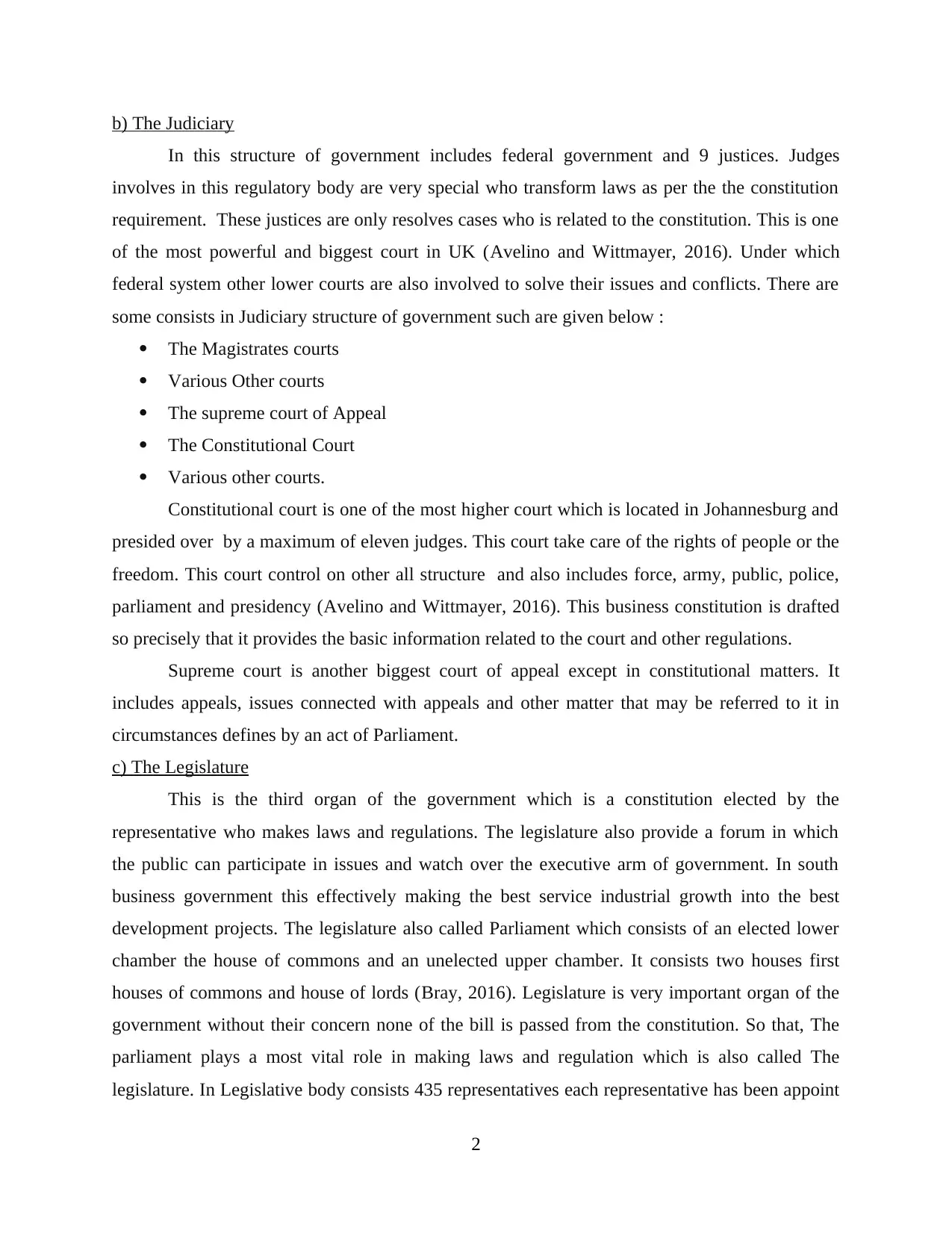
b) The Judiciary
In this structure of government includes federal government and 9 justices. Judges
involves in this regulatory body are very special who transform laws as per the the constitution
requirement. These justices are only resolves cases who is related to the constitution. This is one
of the most powerful and biggest court in UK (Avelino and Wittmayer, 2016). Under which
federal system other lower courts are also involved to solve their issues and conflicts. There are
some consists in Judiciary structure of government such are given below :
The Magistrates courts
Various Other courts
The supreme court of Appeal
The Constitutional Court
Various other courts.
Constitutional court is one of the most higher court which is located in Johannesburg and
presided over by a maximum of eleven judges. This court take care of the rights of people or the
freedom. This court control on other all structure and also includes force, army, public, police,
parliament and presidency (Avelino and Wittmayer, 2016). This business constitution is drafted
so precisely that it provides the basic information related to the court and other regulations.
Supreme court is another biggest court of appeal except in constitutional matters. It
includes appeals, issues connected with appeals and other matter that may be referred to it in
circumstances defines by an act of Parliament.
c) The Legislature
This is the third organ of the government which is a constitution elected by the
representative who makes laws and regulations. The legislature also provide a forum in which
the public can participate in issues and watch over the executive arm of government. In south
business government this effectively making the best service industrial growth into the best
development projects. The legislature also called Parliament which consists of an elected lower
chamber the house of commons and an unelected upper chamber. It consists two houses first
houses of commons and house of lords (Bray, 2016). Legislature is very important organ of the
government without their concern none of the bill is passed from the constitution. So that, The
parliament plays a most vital role in making laws and regulation which is also called The
legislature. In Legislative body consists 435 representatives each representative has been appoint
2
In this structure of government includes federal government and 9 justices. Judges
involves in this regulatory body are very special who transform laws as per the the constitution
requirement. These justices are only resolves cases who is related to the constitution. This is one
of the most powerful and biggest court in UK (Avelino and Wittmayer, 2016). Under which
federal system other lower courts are also involved to solve their issues and conflicts. There are
some consists in Judiciary structure of government such are given below :
The Magistrates courts
Various Other courts
The supreme court of Appeal
The Constitutional Court
Various other courts.
Constitutional court is one of the most higher court which is located in Johannesburg and
presided over by a maximum of eleven judges. This court take care of the rights of people or the
freedom. This court control on other all structure and also includes force, army, public, police,
parliament and presidency (Avelino and Wittmayer, 2016). This business constitution is drafted
so precisely that it provides the basic information related to the court and other regulations.
Supreme court is another biggest court of appeal except in constitutional matters. It
includes appeals, issues connected with appeals and other matter that may be referred to it in
circumstances defines by an act of Parliament.
c) The Legislature
This is the third organ of the government which is a constitution elected by the
representative who makes laws and regulations. The legislature also provide a forum in which
the public can participate in issues and watch over the executive arm of government. In south
business government this effectively making the best service industrial growth into the best
development projects. The legislature also called Parliament which consists of an elected lower
chamber the house of commons and an unelected upper chamber. It consists two houses first
houses of commons and house of lords (Bray, 2016). Legislature is very important organ of the
government without their concern none of the bill is passed from the constitution. So that, The
parliament plays a most vital role in making laws and regulation which is also called The
legislature. In Legislative body consists 435 representatives each representative has been appoint
2
Paraphrase This Document
Need a fresh take? Get an instant paraphrase of this document with our AI Paraphraser
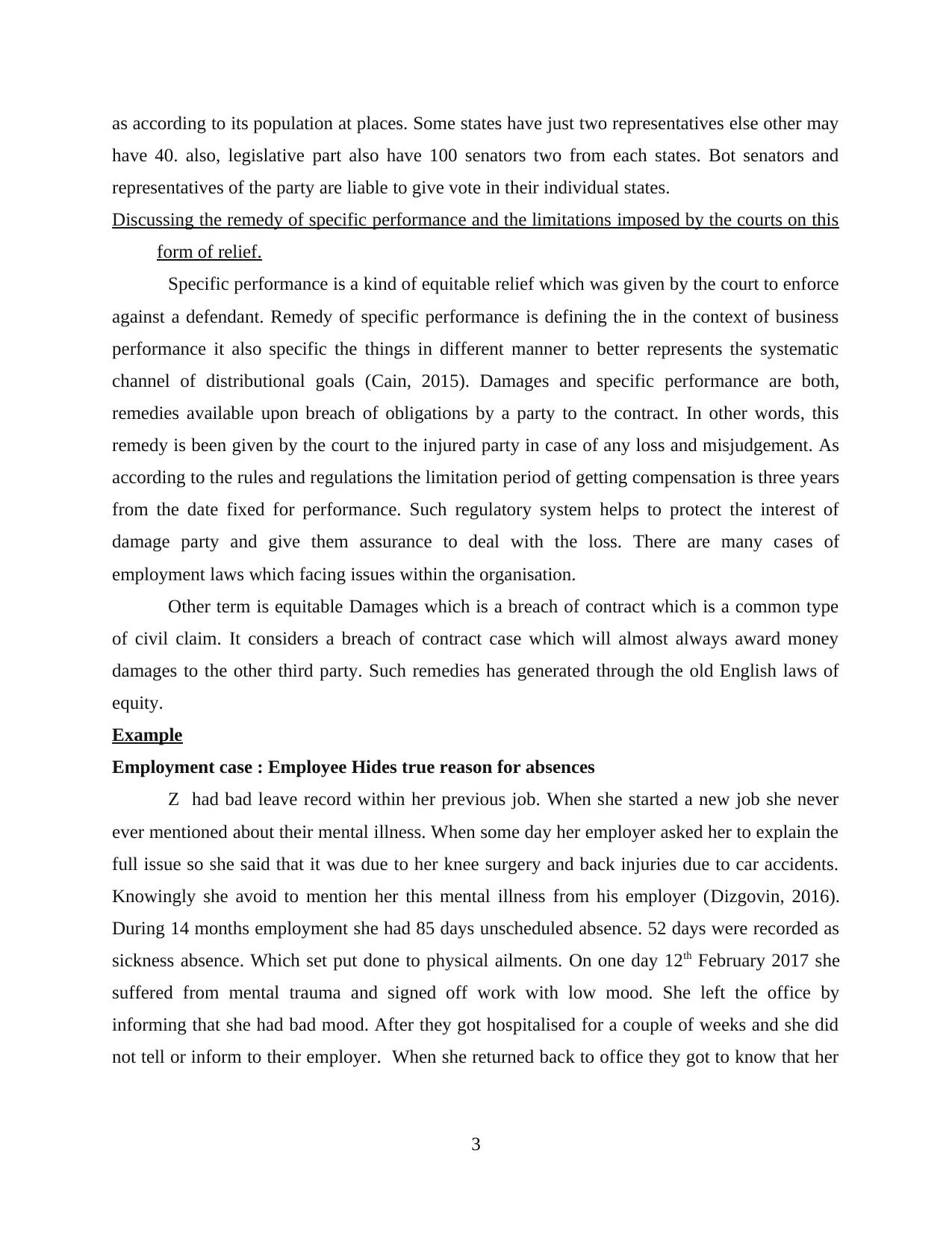
as according to its population at places. Some states have just two representatives else other may
have 40. also, legislative part also have 100 senators two from each states. Bot senators and
representatives of the party are liable to give vote in their individual states.
Discussing the remedy of specific performance and the limitations imposed by the courts on this
form of relief.
Specific performance is a kind of equitable relief which was given by the court to enforce
against a defendant. Remedy of specific performance is defining the in the context of business
performance it also specific the things in different manner to better represents the systematic
channel of distributional goals (Cain, 2015). Damages and specific performance are both,
remedies available upon breach of obligations by a party to the contract. In other words, this
remedy is been given by the court to the injured party in case of any loss and misjudgement. As
according to the rules and regulations the limitation period of getting compensation is three years
from the date fixed for performance. Such regulatory system helps to protect the interest of
damage party and give them assurance to deal with the loss. There are many cases of
employment laws which facing issues within the organisation.
Other term is equitable Damages which is a breach of contract which is a common type
of civil claim. It considers a breach of contract case which will almost always award money
damages to the other third party. Such remedies has generated through the old English laws of
equity.
Example
Employment case : Employee Hides true reason for absences
Z had bad leave record within her previous job. When she started a new job she never
ever mentioned about their mental illness. When some day her employer asked her to explain the
full issue so she said that it was due to her knee surgery and back injuries due to car accidents.
Knowingly she avoid to mention her this mental illness from his employer (Dizgovin, 2016).
During 14 months employment she had 85 days unscheduled absence. 52 days were recorded as
sickness absence. Which set put done to physical ailments. On one day 12th February 2017 she
suffered from mental trauma and signed off work with low mood. She left the office by
informing that she had bad mood. After they got hospitalised for a couple of weeks and she did
not tell or inform to their employer. When she returned back to office they got to know that her
3
have 40. also, legislative part also have 100 senators two from each states. Bot senators and
representatives of the party are liable to give vote in their individual states.
Discussing the remedy of specific performance and the limitations imposed by the courts on this
form of relief.
Specific performance is a kind of equitable relief which was given by the court to enforce
against a defendant. Remedy of specific performance is defining the in the context of business
performance it also specific the things in different manner to better represents the systematic
channel of distributional goals (Cain, 2015). Damages and specific performance are both,
remedies available upon breach of obligations by a party to the contract. In other words, this
remedy is been given by the court to the injured party in case of any loss and misjudgement. As
according to the rules and regulations the limitation period of getting compensation is three years
from the date fixed for performance. Such regulatory system helps to protect the interest of
damage party and give them assurance to deal with the loss. There are many cases of
employment laws which facing issues within the organisation.
Other term is equitable Damages which is a breach of contract which is a common type
of civil claim. It considers a breach of contract case which will almost always award money
damages to the other third party. Such remedies has generated through the old English laws of
equity.
Example
Employment case : Employee Hides true reason for absences
Z had bad leave record within her previous job. When she started a new job she never
ever mentioned about their mental illness. When some day her employer asked her to explain the
full issue so she said that it was due to her knee surgery and back injuries due to car accidents.
Knowingly she avoid to mention her this mental illness from his employer (Dizgovin, 2016).
During 14 months employment she had 85 days unscheduled absence. 52 days were recorded as
sickness absence. Which set put done to physical ailments. On one day 12th February 2017 she
suffered from mental trauma and signed off work with low mood. She left the office by
informing that she had bad mood. After they got hospitalised for a couple of weeks and she did
not tell or inform to their employer. When she returned back to office they got to know that her
3
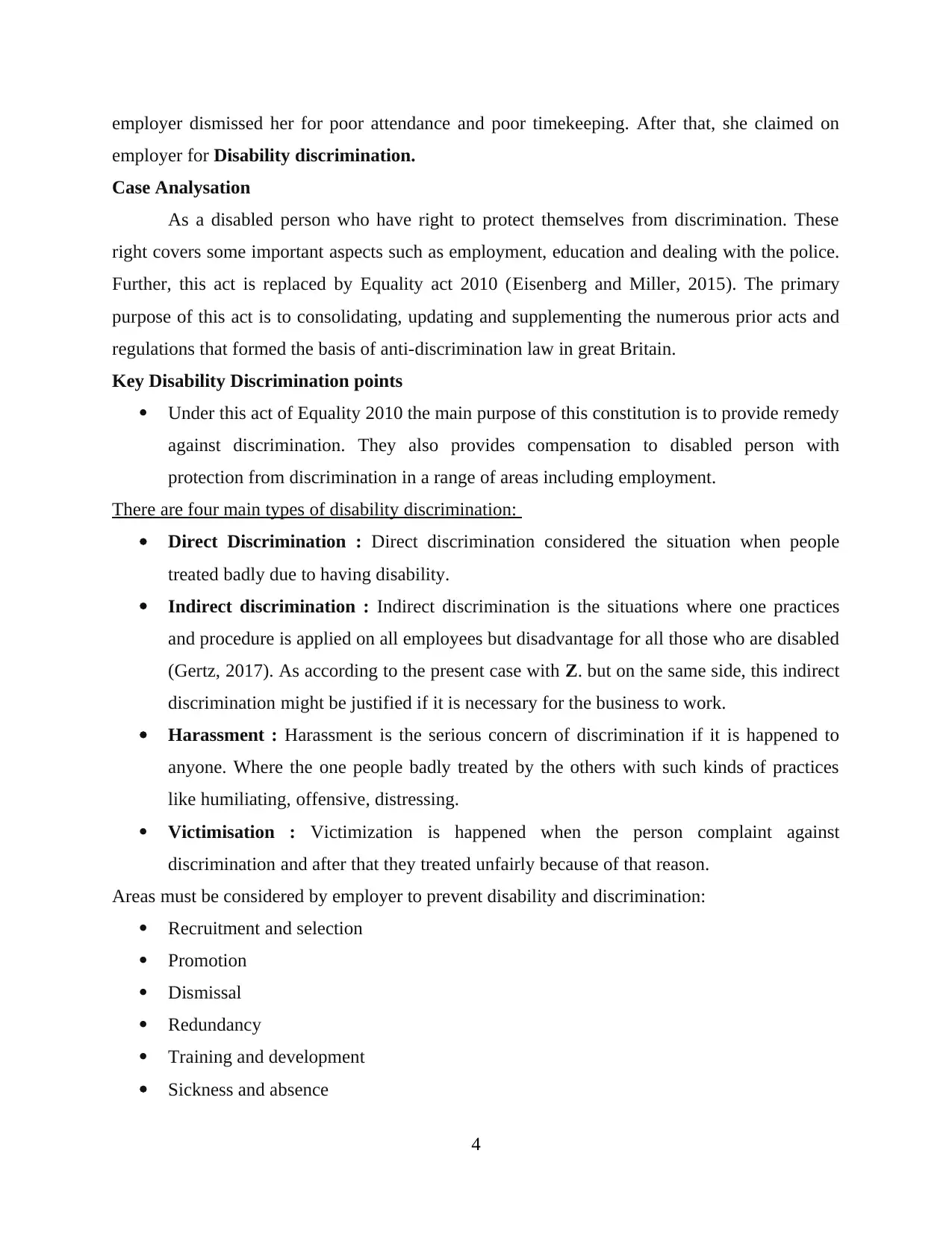
employer dismissed her for poor attendance and poor timekeeping. After that, she claimed on
employer for Disability discrimination.
Case Analysation
As a disabled person who have right to protect themselves from discrimination. These
right covers some important aspects such as employment, education and dealing with the police.
Further, this act is replaced by Equality act 2010 (Eisenberg and Miller, 2015). The primary
purpose of this act is to consolidating, updating and supplementing the numerous prior acts and
regulations that formed the basis of anti-discrimination law in great Britain.
Key Disability Discrimination points
Under this act of Equality 2010 the main purpose of this constitution is to provide remedy
against discrimination. They also provides compensation to disabled person with
protection from discrimination in a range of areas including employment.
There are four main types of disability discrimination:
Direct Discrimination : Direct discrimination considered the situation when people
treated badly due to having disability.
Indirect discrimination : Indirect discrimination is the situations where one practices
and procedure is applied on all employees but disadvantage for all those who are disabled
(Gertz, 2017). As according to the present case with Z. but on the same side, this indirect
discrimination might be justified if it is necessary for the business to work.
Harassment : Harassment is the serious concern of discrimination if it is happened to
anyone. Where the one people badly treated by the others with such kinds of practices
like humiliating, offensive, distressing.
Victimisation : Victimization is happened when the person complaint against
discrimination and after that they treated unfairly because of that reason.
Areas must be considered by employer to prevent disability and discrimination:
Recruitment and selection
Promotion
Dismissal
Redundancy
Training and development
Sickness and absence
4
employer for Disability discrimination.
Case Analysation
As a disabled person who have right to protect themselves from discrimination. These
right covers some important aspects such as employment, education and dealing with the police.
Further, this act is replaced by Equality act 2010 (Eisenberg and Miller, 2015). The primary
purpose of this act is to consolidating, updating and supplementing the numerous prior acts and
regulations that formed the basis of anti-discrimination law in great Britain.
Key Disability Discrimination points
Under this act of Equality 2010 the main purpose of this constitution is to provide remedy
against discrimination. They also provides compensation to disabled person with
protection from discrimination in a range of areas including employment.
There are four main types of disability discrimination:
Direct Discrimination : Direct discrimination considered the situation when people
treated badly due to having disability.
Indirect discrimination : Indirect discrimination is the situations where one practices
and procedure is applied on all employees but disadvantage for all those who are disabled
(Gertz, 2017). As according to the present case with Z. but on the same side, this indirect
discrimination might be justified if it is necessary for the business to work.
Harassment : Harassment is the serious concern of discrimination if it is happened to
anyone. Where the one people badly treated by the others with such kinds of practices
like humiliating, offensive, distressing.
Victimisation : Victimization is happened when the person complaint against
discrimination and after that they treated unfairly because of that reason.
Areas must be considered by employer to prevent disability and discrimination:
Recruitment and selection
Promotion
Dismissal
Redundancy
Training and development
Sickness and absence
4
⊘ This is a preview!⊘
Do you want full access?
Subscribe today to unlock all pages.

Trusted by 1+ million students worldwide
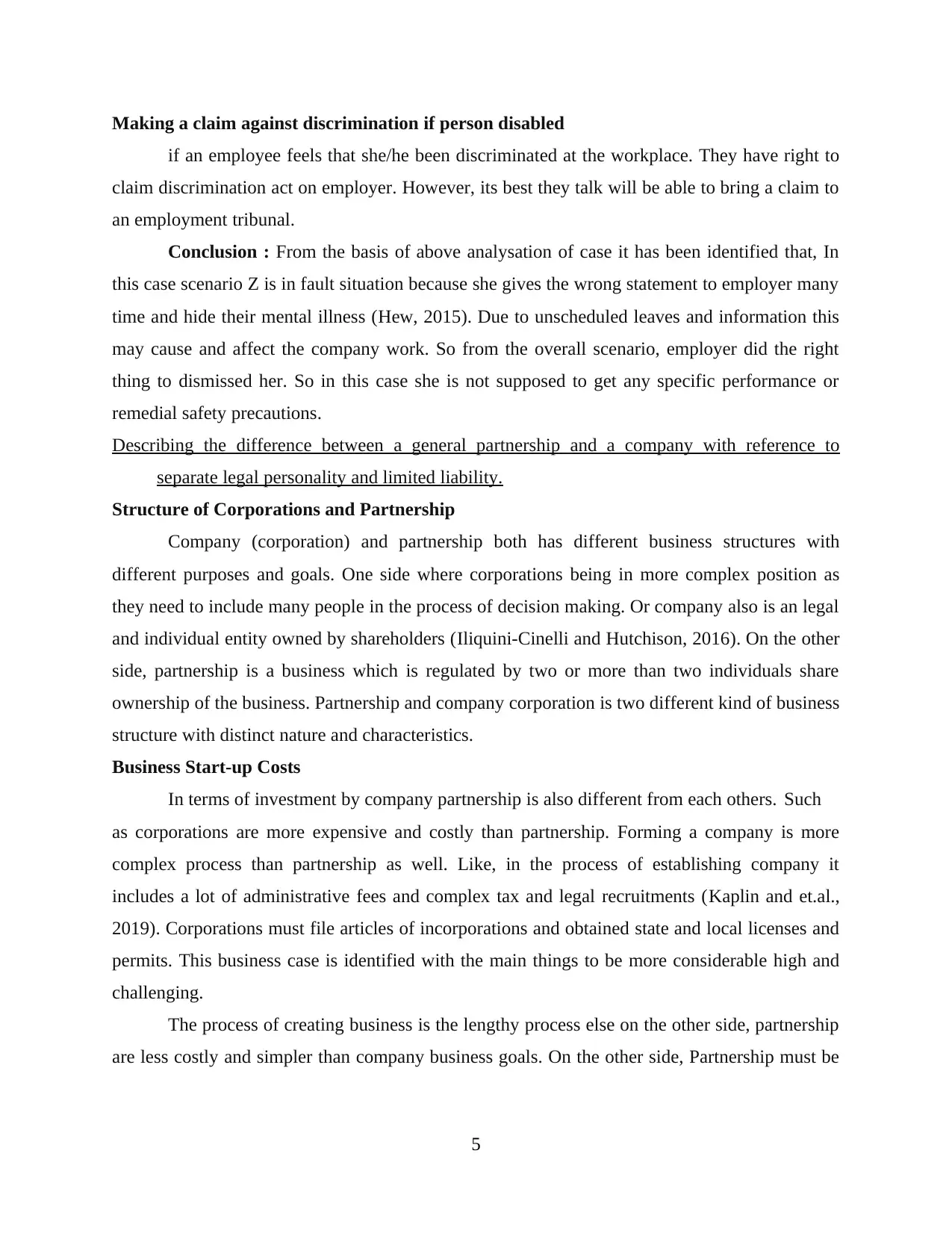
Making a claim against discrimination if person disabled
if an employee feels that she/he been discriminated at the workplace. They have right to
claim discrimination act on employer. However, its best they talk will be able to bring a claim to
an employment tribunal.
Conclusion : From the basis of above analysation of case it has been identified that, In
this case scenario Z is in fault situation because she gives the wrong statement to employer many
time and hide their mental illness (Hew, 2015). Due to unscheduled leaves and information this
may cause and affect the company work. So from the overall scenario, employer did the right
thing to dismissed her. So in this case she is not supposed to get any specific performance or
remedial safety precautions.
Describing the difference between a general partnership and a company with reference to
separate legal personality and limited liability.
Structure of Corporations and Partnership
Company (corporation) and partnership both has different business structures with
different purposes and goals. One side where corporations being in more complex position as
they need to include many people in the process of decision making. Or company also is an legal
and individual entity owned by shareholders (Iliquini-Cinelli and Hutchison, 2016). On the other
side, partnership is a business which is regulated by two or more than two individuals share
ownership of the business. Partnership and company corporation is two different kind of business
structure with distinct nature and characteristics.
Business Start-up Costs
In terms of investment by company partnership is also different from each others. Such
as corporations are more expensive and costly than partnership. Forming a company is more
complex process than partnership as well. Like, in the process of establishing company it
includes a lot of administrative fees and complex tax and legal recruitments (Kaplin and et.al.,
2019). Corporations must file articles of incorporations and obtained state and local licenses and
permits. This business case is identified with the main things to be more considerable high and
challenging.
The process of creating business is the lengthy process else on the other side, partnership
are less costly and simpler than company business goals. On the other side, Partnership must be
5
if an employee feels that she/he been discriminated at the workplace. They have right to
claim discrimination act on employer. However, its best they talk will be able to bring a claim to
an employment tribunal.
Conclusion : From the basis of above analysation of case it has been identified that, In
this case scenario Z is in fault situation because she gives the wrong statement to employer many
time and hide their mental illness (Hew, 2015). Due to unscheduled leaves and information this
may cause and affect the company work. So from the overall scenario, employer did the right
thing to dismissed her. So in this case she is not supposed to get any specific performance or
remedial safety precautions.
Describing the difference between a general partnership and a company with reference to
separate legal personality and limited liability.
Structure of Corporations and Partnership
Company (corporation) and partnership both has different business structures with
different purposes and goals. One side where corporations being in more complex position as
they need to include many people in the process of decision making. Or company also is an legal
and individual entity owned by shareholders (Iliquini-Cinelli and Hutchison, 2016). On the other
side, partnership is a business which is regulated by two or more than two individuals share
ownership of the business. Partnership and company corporation is two different kind of business
structure with distinct nature and characteristics.
Business Start-up Costs
In terms of investment by company partnership is also different from each others. Such
as corporations are more expensive and costly than partnership. Forming a company is more
complex process than partnership as well. Like, in the process of establishing company it
includes a lot of administrative fees and complex tax and legal recruitments (Kaplin and et.al.,
2019). Corporations must file articles of incorporations and obtained state and local licenses and
permits. This business case is identified with the main things to be more considerable high and
challenging.
The process of creating business is the lengthy process else on the other side, partnership
are less costly and simpler than company business goals. On the other side, Partnership must be
5
Paraphrase This Document
Need a fresh take? Get an instant paraphrase of this document with our AI Paraphraser
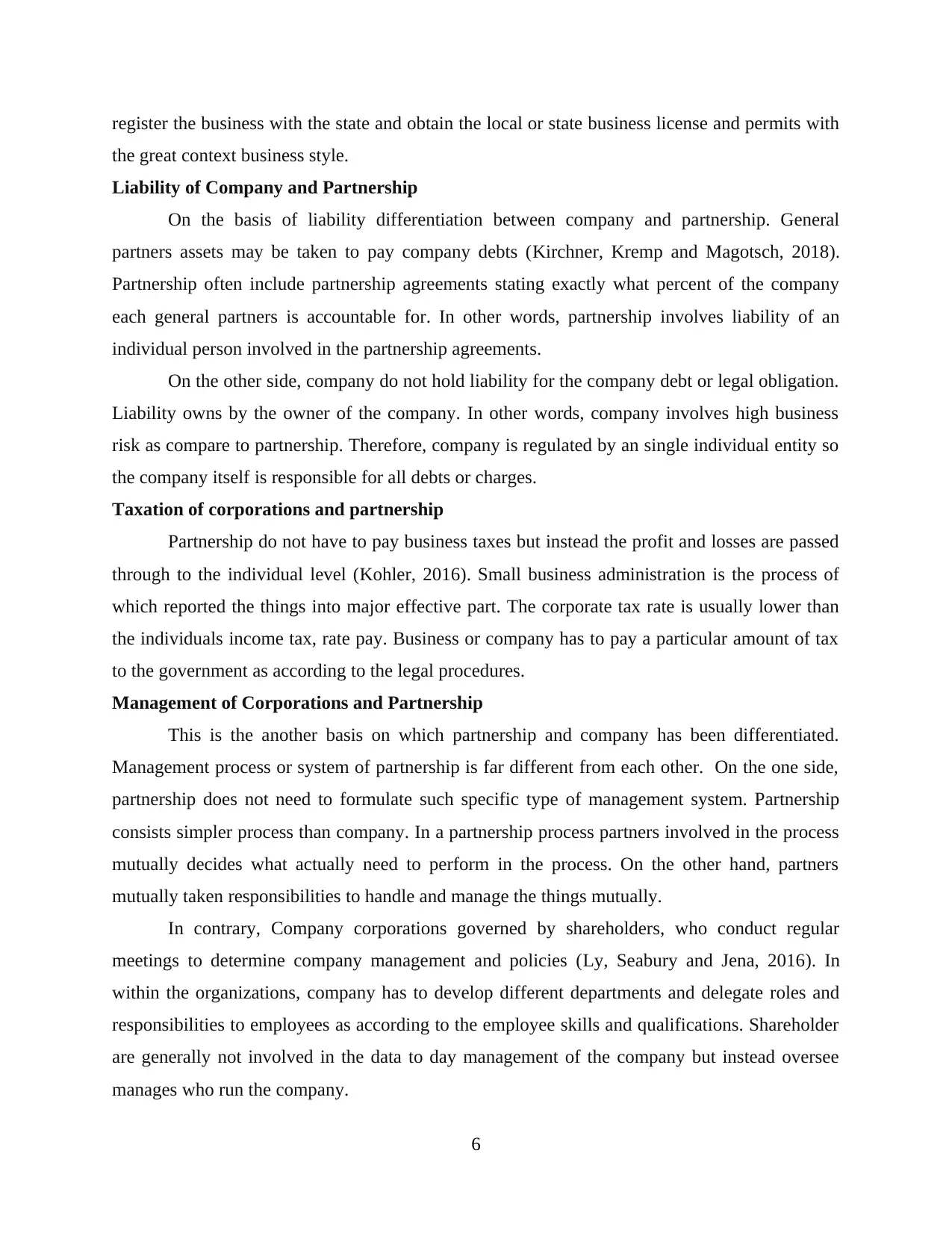
register the business with the state and obtain the local or state business license and permits with
the great context business style.
Liability of Company and Partnership
On the basis of liability differentiation between company and partnership. General
partners assets may be taken to pay company debts (Kirchner, Kremp and Magotsch, 2018).
Partnership often include partnership agreements stating exactly what percent of the company
each general partners is accountable for. In other words, partnership involves liability of an
individual person involved in the partnership agreements.
On the other side, company do not hold liability for the company debt or legal obligation.
Liability owns by the owner of the company. In other words, company involves high business
risk as compare to partnership. Therefore, company is regulated by an single individual entity so
the company itself is responsible for all debts or charges.
Taxation of corporations and partnership
Partnership do not have to pay business taxes but instead the profit and losses are passed
through to the individual level (Kohler, 2016). Small business administration is the process of
which reported the things into major effective part. The corporate tax rate is usually lower than
the individuals income tax, rate pay. Business or company has to pay a particular amount of tax
to the government as according to the legal procedures.
Management of Corporations and Partnership
This is the another basis on which partnership and company has been differentiated.
Management process or system of partnership is far different from each other. On the one side,
partnership does not need to formulate such specific type of management system. Partnership
consists simpler process than company. In a partnership process partners involved in the process
mutually decides what actually need to perform in the process. On the other hand, partners
mutually taken responsibilities to handle and manage the things mutually.
In contrary, Company corporations governed by shareholders, who conduct regular
meetings to determine company management and policies (Ly, Seabury and Jena, 2016). In
within the organizations, company has to develop different departments and delegate roles and
responsibilities to employees as according to the employee skills and qualifications. Shareholder
are generally not involved in the data to day management of the company but instead oversee
manages who run the company.
6
the great context business style.
Liability of Company and Partnership
On the basis of liability differentiation between company and partnership. General
partners assets may be taken to pay company debts (Kirchner, Kremp and Magotsch, 2018).
Partnership often include partnership agreements stating exactly what percent of the company
each general partners is accountable for. In other words, partnership involves liability of an
individual person involved in the partnership agreements.
On the other side, company do not hold liability for the company debt or legal obligation.
Liability owns by the owner of the company. In other words, company involves high business
risk as compare to partnership. Therefore, company is regulated by an single individual entity so
the company itself is responsible for all debts or charges.
Taxation of corporations and partnership
Partnership do not have to pay business taxes but instead the profit and losses are passed
through to the individual level (Kohler, 2016). Small business administration is the process of
which reported the things into major effective part. The corporate tax rate is usually lower than
the individuals income tax, rate pay. Business or company has to pay a particular amount of tax
to the government as according to the legal procedures.
Management of Corporations and Partnership
This is the another basis on which partnership and company has been differentiated.
Management process or system of partnership is far different from each other. On the one side,
partnership does not need to formulate such specific type of management system. Partnership
consists simpler process than company. In a partnership process partners involved in the process
mutually decides what actually need to perform in the process. On the other hand, partners
mutually taken responsibilities to handle and manage the things mutually.
In contrary, Company corporations governed by shareholders, who conduct regular
meetings to determine company management and policies (Ly, Seabury and Jena, 2016). In
within the organizations, company has to develop different departments and delegate roles and
responsibilities to employees as according to the employee skills and qualifications. Shareholder
are generally not involved in the data to day management of the company but instead oversee
manages who run the company.
6
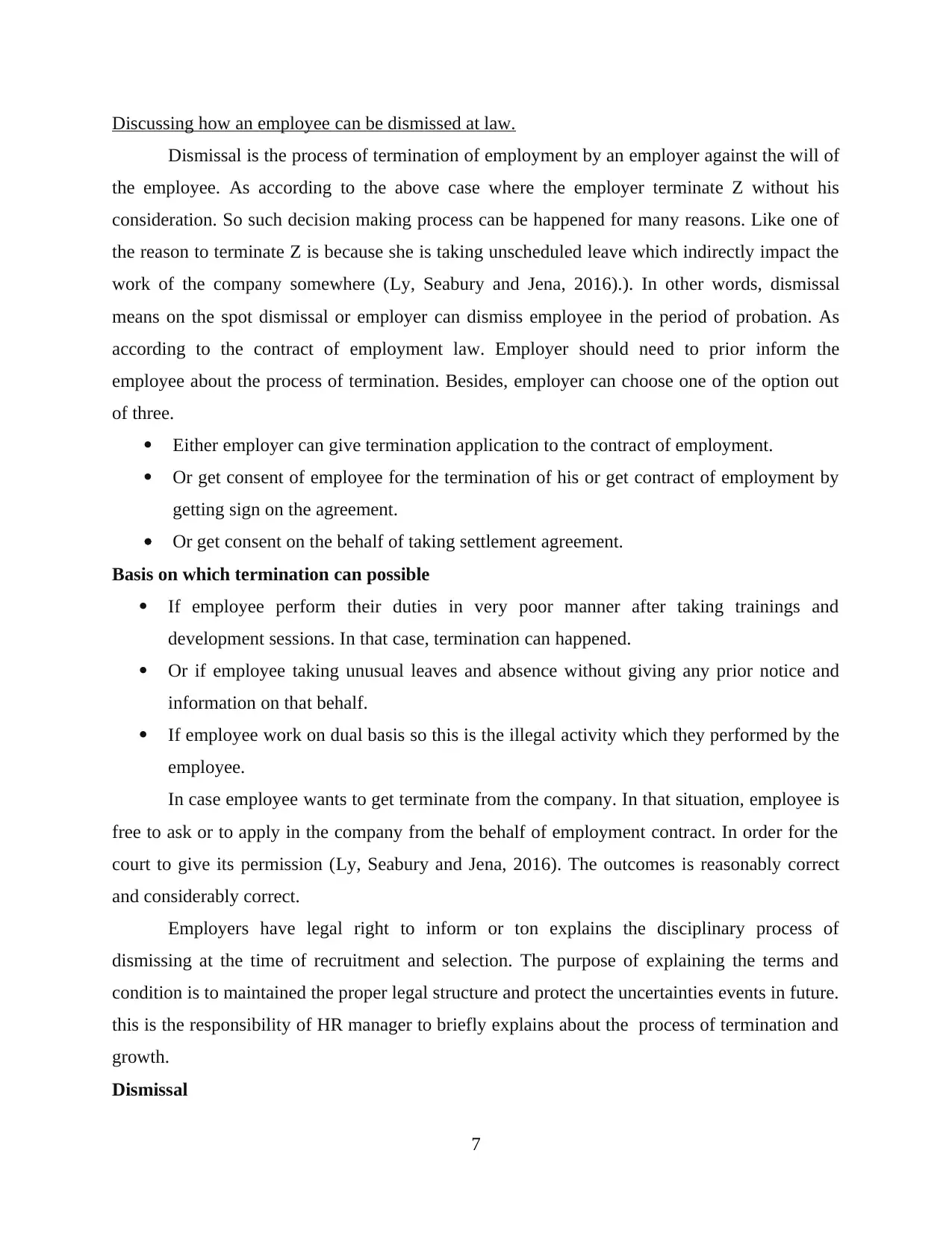
Discussing how an employee can be dismissed at law.
Dismissal is the process of termination of employment by an employer against the will of
the employee. As according to the above case where the employer terminate Z without his
consideration. So such decision making process can be happened for many reasons. Like one of
the reason to terminate Z is because she is taking unscheduled leave which indirectly impact the
work of the company somewhere (Ly, Seabury and Jena, 2016).). In other words, dismissal
means on the spot dismissal or employer can dismiss employee in the period of probation. As
according to the contract of employment law. Employer should need to prior inform the
employee about the process of termination. Besides, employer can choose one of the option out
of three.
Either employer can give termination application to the contract of employment.
Or get consent of employee for the termination of his or get contract of employment by
getting sign on the agreement.
Or get consent on the behalf of taking settlement agreement.
Basis on which termination can possible
If employee perform their duties in very poor manner after taking trainings and
development sessions. In that case, termination can happened.
Or if employee taking unusual leaves and absence without giving any prior notice and
information on that behalf.
If employee work on dual basis so this is the illegal activity which they performed by the
employee.
In case employee wants to get terminate from the company. In that situation, employee is
free to ask or to apply in the company from the behalf of employment contract. In order for the
court to give its permission (Ly, Seabury and Jena, 2016). The outcomes is reasonably correct
and considerably correct.
Employers have legal right to inform or ton explains the disciplinary process of
dismissing at the time of recruitment and selection. The purpose of explaining the terms and
condition is to maintained the proper legal structure and protect the uncertainties events in future.
this is the responsibility of HR manager to briefly explains about the process of termination and
growth.
Dismissal
7
Dismissal is the process of termination of employment by an employer against the will of
the employee. As according to the above case where the employer terminate Z without his
consideration. So such decision making process can be happened for many reasons. Like one of
the reason to terminate Z is because she is taking unscheduled leave which indirectly impact the
work of the company somewhere (Ly, Seabury and Jena, 2016).). In other words, dismissal
means on the spot dismissal or employer can dismiss employee in the period of probation. As
according to the contract of employment law. Employer should need to prior inform the
employee about the process of termination. Besides, employer can choose one of the option out
of three.
Either employer can give termination application to the contract of employment.
Or get consent of employee for the termination of his or get contract of employment by
getting sign on the agreement.
Or get consent on the behalf of taking settlement agreement.
Basis on which termination can possible
If employee perform their duties in very poor manner after taking trainings and
development sessions. In that case, termination can happened.
Or if employee taking unusual leaves and absence without giving any prior notice and
information on that behalf.
If employee work on dual basis so this is the illegal activity which they performed by the
employee.
In case employee wants to get terminate from the company. In that situation, employee is
free to ask or to apply in the company from the behalf of employment contract. In order for the
court to give its permission (Ly, Seabury and Jena, 2016). The outcomes is reasonably correct
and considerably correct.
Employers have legal right to inform or ton explains the disciplinary process of
dismissing at the time of recruitment and selection. The purpose of explaining the terms and
condition is to maintained the proper legal structure and protect the uncertainties events in future.
this is the responsibility of HR manager to briefly explains about the process of termination and
growth.
Dismissal
7
⊘ This is a preview!⊘
Do you want full access?
Subscribe today to unlock all pages.

Trusted by 1+ million students worldwide
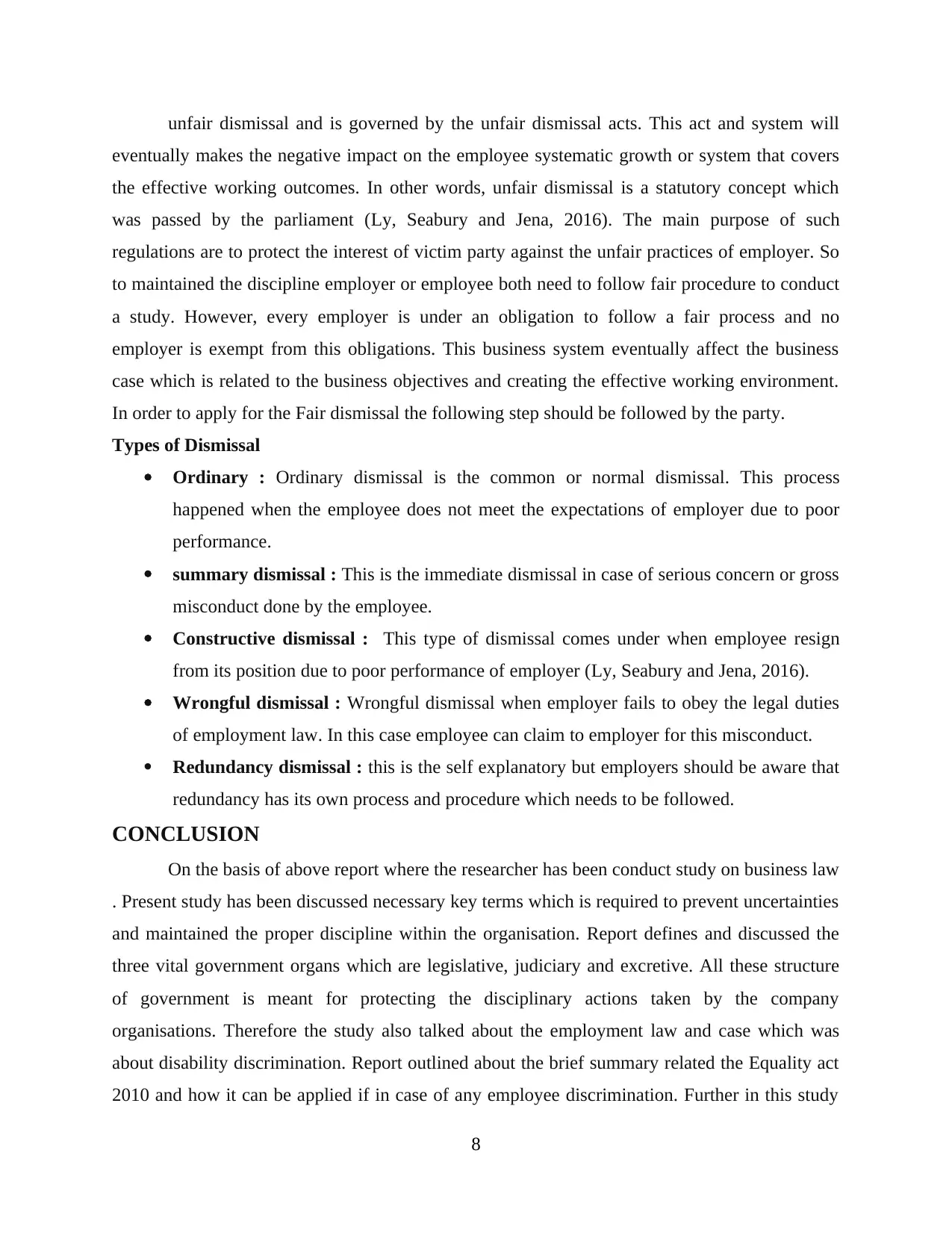
unfair dismissal and is governed by the unfair dismissal acts. This act and system will
eventually makes the negative impact on the employee systematic growth or system that covers
the effective working outcomes. In other words, unfair dismissal is a statutory concept which
was passed by the parliament (Ly, Seabury and Jena, 2016). The main purpose of such
regulations are to protect the interest of victim party against the unfair practices of employer. So
to maintained the discipline employer or employee both need to follow fair procedure to conduct
a study. However, every employer is under an obligation to follow a fair process and no
employer is exempt from this obligations. This business system eventually affect the business
case which is related to the business objectives and creating the effective working environment.
In order to apply for the Fair dismissal the following step should be followed by the party.
Types of Dismissal
Ordinary : Ordinary dismissal is the common or normal dismissal. This process
happened when the employee does not meet the expectations of employer due to poor
performance.
summary dismissal : This is the immediate dismissal in case of serious concern or gross
misconduct done by the employee.
Constructive dismissal : This type of dismissal comes under when employee resign
from its position due to poor performance of employer (Ly, Seabury and Jena, 2016).
Wrongful dismissal : Wrongful dismissal when employer fails to obey the legal duties
of employment law. In this case employee can claim to employer for this misconduct.
Redundancy dismissal : this is the self explanatory but employers should be aware that
redundancy has its own process and procedure which needs to be followed.
CONCLUSION
On the basis of above report where the researcher has been conduct study on business law
. Present study has been discussed necessary key terms which is required to prevent uncertainties
and maintained the proper discipline within the organisation. Report defines and discussed the
three vital government organs which are legislative, judiciary and excretive. All these structure
of government is meant for protecting the disciplinary actions taken by the company
organisations. Therefore the study also talked about the employment law and case which was
about disability discrimination. Report outlined about the brief summary related the Equality act
2010 and how it can be applied if in case of any employee discrimination. Further in this study
8
eventually makes the negative impact on the employee systematic growth or system that covers
the effective working outcomes. In other words, unfair dismissal is a statutory concept which
was passed by the parliament (Ly, Seabury and Jena, 2016). The main purpose of such
regulations are to protect the interest of victim party against the unfair practices of employer. So
to maintained the discipline employer or employee both need to follow fair procedure to conduct
a study. However, every employer is under an obligation to follow a fair process and no
employer is exempt from this obligations. This business system eventually affect the business
case which is related to the business objectives and creating the effective working environment.
In order to apply for the Fair dismissal the following step should be followed by the party.
Types of Dismissal
Ordinary : Ordinary dismissal is the common or normal dismissal. This process
happened when the employee does not meet the expectations of employer due to poor
performance.
summary dismissal : This is the immediate dismissal in case of serious concern or gross
misconduct done by the employee.
Constructive dismissal : This type of dismissal comes under when employee resign
from its position due to poor performance of employer (Ly, Seabury and Jena, 2016).
Wrongful dismissal : Wrongful dismissal when employer fails to obey the legal duties
of employment law. In this case employee can claim to employer for this misconduct.
Redundancy dismissal : this is the self explanatory but employers should be aware that
redundancy has its own process and procedure which needs to be followed.
CONCLUSION
On the basis of above report where the researcher has been conduct study on business law
. Present study has been discussed necessary key terms which is required to prevent uncertainties
and maintained the proper discipline within the organisation. Report defines and discussed the
three vital government organs which are legislative, judiciary and excretive. All these structure
of government is meant for protecting the disciplinary actions taken by the company
organisations. Therefore the study also talked about the employment law and case which was
about disability discrimination. Report outlined about the brief summary related the Equality act
2010 and how it can be applied if in case of any employee discrimination. Further in this study
8
Paraphrase This Document
Need a fresh take? Get an instant paraphrase of this document with our AI Paraphraser
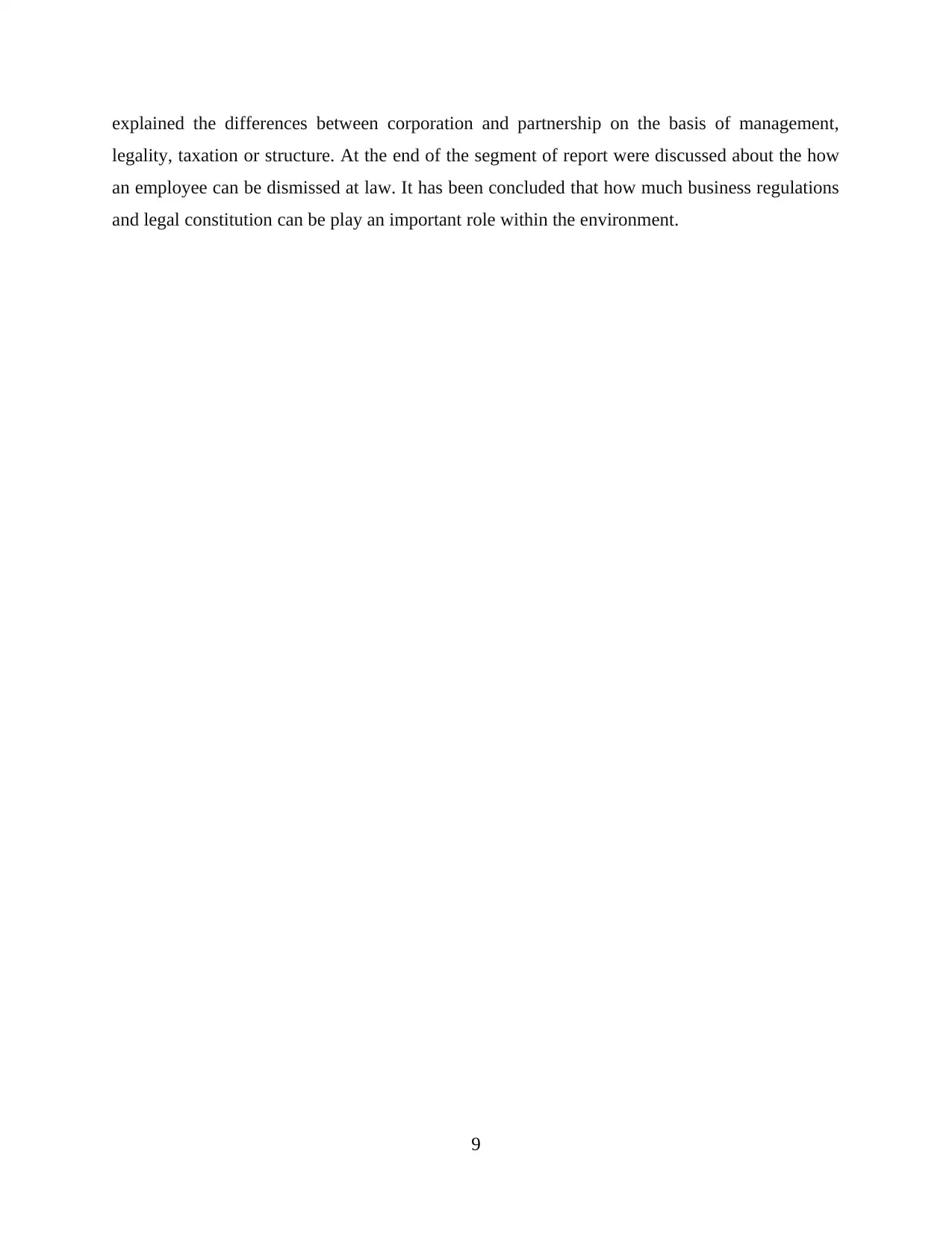
explained the differences between corporation and partnership on the basis of management,
legality, taxation or structure. At the end of the segment of report were discussed about the how
an employee can be dismissed at law. It has been concluded that how much business regulations
and legal constitution can be play an important role within the environment.
9
legality, taxation or structure. At the end of the segment of report were discussed about the how
an employee can be dismissed at law. It has been concluded that how much business regulations
and legal constitution can be play an important role within the environment.
9
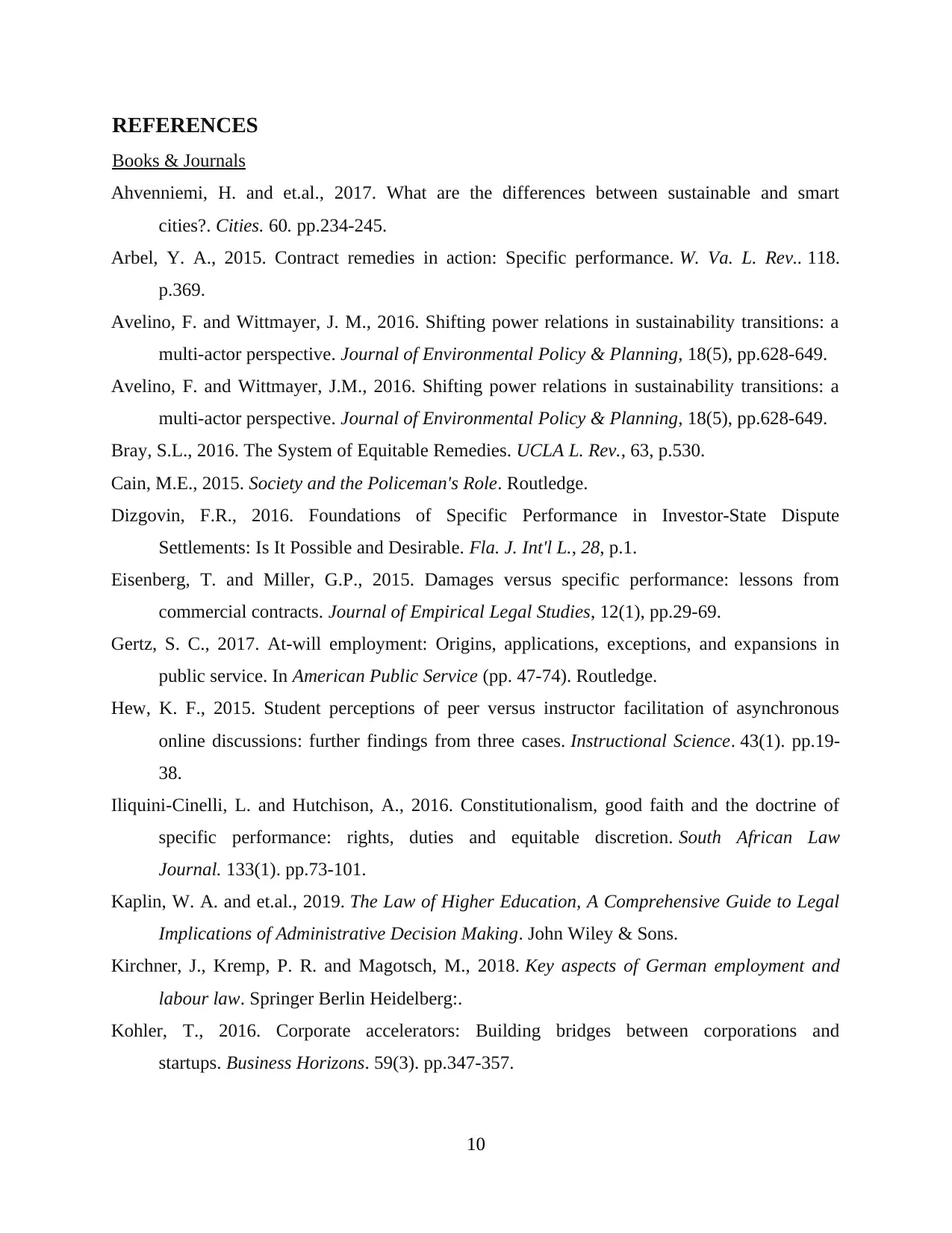
REFERENCES
Books & Journals
Ahvenniemi, H. and et.al., 2017. What are the differences between sustainable and smart
cities?. Cities. 60. pp.234-245.
Arbel, Y. A., 2015. Contract remedies in action: Specific performance. W. Va. L. Rev.. 118.
p.369.
Avelino, F. and Wittmayer, J. M., 2016. Shifting power relations in sustainability transitions: a
multi-actor perspective. Journal of Environmental Policy & Planning, 18(5), pp.628-649.
Avelino, F. and Wittmayer, J.M., 2016. Shifting power relations in sustainability transitions: a
multi-actor perspective. Journal of Environmental Policy & Planning, 18(5), pp.628-649.
Bray, S.L., 2016. The System of Equitable Remedies. UCLA L. Rev., 63, p.530.
Cain, M.E., 2015. Society and the Policeman's Role. Routledge.
Dizgovin, F.R., 2016. Foundations of Specific Performance in Investor-State Dispute
Settlements: Is It Possible and Desirable. Fla. J. Int'l L., 28, p.1.
Eisenberg, T. and Miller, G.P., 2015. Damages versus specific performance: lessons from
commercial contracts. Journal of Empirical Legal Studies, 12(1), pp.29-69.
Gertz, S. C., 2017. At-will employment: Origins, applications, exceptions, and expansions in
public service. In American Public Service (pp. 47-74). Routledge.
Hew, K. F., 2015. Student perceptions of peer versus instructor facilitation of asynchronous
online discussions: further findings from three cases. Instructional Science. 43(1). pp.19-
38.
Iliquini-Cinelli, L. and Hutchison, A., 2016. Constitutionalism, good faith and the doctrine of
specific performance: rights, duties and equitable discretion. South African Law
Journal. 133(1). pp.73-101.
Kaplin, W. A. and et.al., 2019. The Law of Higher Education, A Comprehensive Guide to Legal
Implications of Administrative Decision Making. John Wiley & Sons.
Kirchner, J., Kremp, P. R. and Magotsch, M., 2018. Key aspects of German employment and
labour law. Springer Berlin Heidelberg:.
Kohler, T., 2016. Corporate accelerators: Building bridges between corporations and
startups. Business Horizons. 59(3). pp.347-357.
10
Books & Journals
Ahvenniemi, H. and et.al., 2017. What are the differences between sustainable and smart
cities?. Cities. 60. pp.234-245.
Arbel, Y. A., 2015. Contract remedies in action: Specific performance. W. Va. L. Rev.. 118.
p.369.
Avelino, F. and Wittmayer, J. M., 2016. Shifting power relations in sustainability transitions: a
multi-actor perspective. Journal of Environmental Policy & Planning, 18(5), pp.628-649.
Avelino, F. and Wittmayer, J.M., 2016. Shifting power relations in sustainability transitions: a
multi-actor perspective. Journal of Environmental Policy & Planning, 18(5), pp.628-649.
Bray, S.L., 2016. The System of Equitable Remedies. UCLA L. Rev., 63, p.530.
Cain, M.E., 2015. Society and the Policeman's Role. Routledge.
Dizgovin, F.R., 2016. Foundations of Specific Performance in Investor-State Dispute
Settlements: Is It Possible and Desirable. Fla. J. Int'l L., 28, p.1.
Eisenberg, T. and Miller, G.P., 2015. Damages versus specific performance: lessons from
commercial contracts. Journal of Empirical Legal Studies, 12(1), pp.29-69.
Gertz, S. C., 2017. At-will employment: Origins, applications, exceptions, and expansions in
public service. In American Public Service (pp. 47-74). Routledge.
Hew, K. F., 2015. Student perceptions of peer versus instructor facilitation of asynchronous
online discussions: further findings from three cases. Instructional Science. 43(1). pp.19-
38.
Iliquini-Cinelli, L. and Hutchison, A., 2016. Constitutionalism, good faith and the doctrine of
specific performance: rights, duties and equitable discretion. South African Law
Journal. 133(1). pp.73-101.
Kaplin, W. A. and et.al., 2019. The Law of Higher Education, A Comprehensive Guide to Legal
Implications of Administrative Decision Making. John Wiley & Sons.
Kirchner, J., Kremp, P. R. and Magotsch, M., 2018. Key aspects of German employment and
labour law. Springer Berlin Heidelberg:.
Kohler, T., 2016. Corporate accelerators: Building bridges between corporations and
startups. Business Horizons. 59(3). pp.347-357.
10
⊘ This is a preview!⊘
Do you want full access?
Subscribe today to unlock all pages.

Trusted by 1+ million students worldwide
1 out of 13
Related Documents
Your All-in-One AI-Powered Toolkit for Academic Success.
+13062052269
info@desklib.com
Available 24*7 on WhatsApp / Email
![[object Object]](/_next/static/media/star-bottom.7253800d.svg)
Unlock your academic potential
Copyright © 2020–2025 A2Z Services. All Rights Reserved. Developed and managed by ZUCOL.





